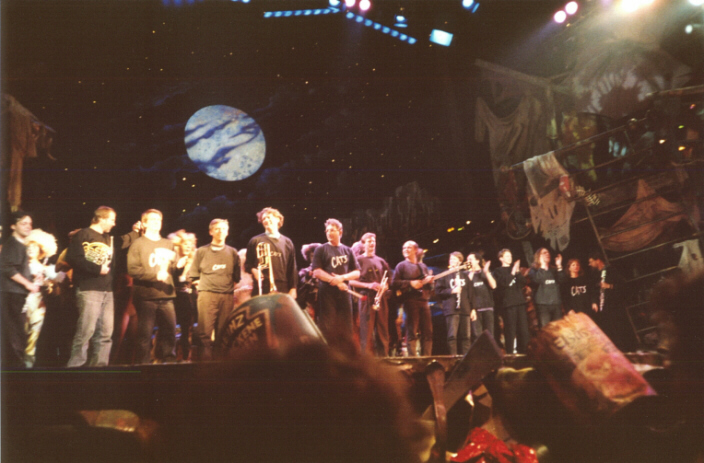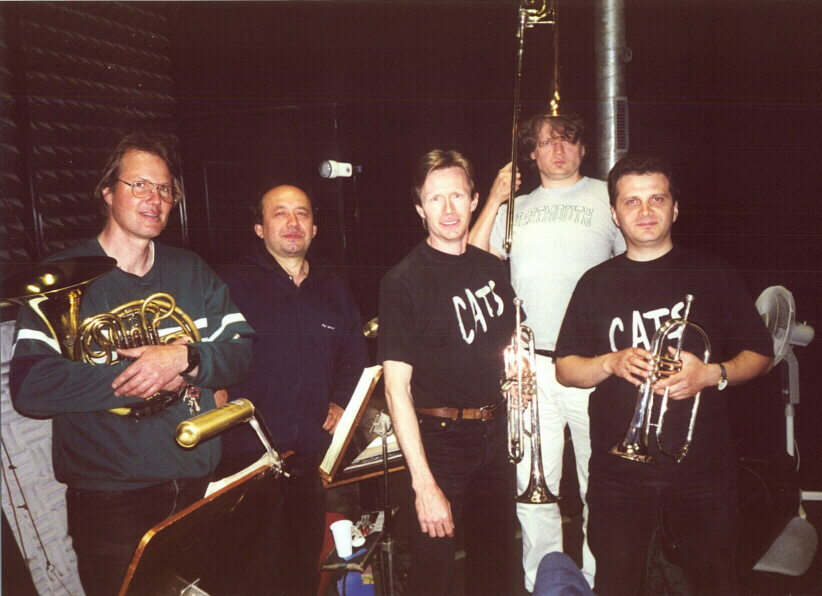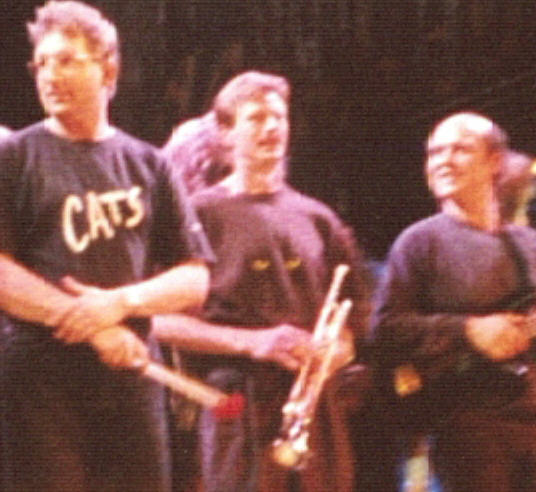How I Became a Student of Claude Gordon by John Mohan
My name is John Mohan and I was a student of Claude Gordon from 1979 until 1995, although I only studied part-time between 1987 and 1990 due to my being on the road as Musical Director and Trumpet Soloist for two different international Circuses during that time. I consider myself extremely fortunate in having had the opportunity to study with Claude, as I feel that his tutorship is largely responsible for my success as a professional trumpet player.



I found out about Mr. Gordon when I was a sophomore or junior in High School growing up in a suburb of Chicago. I was a pretty good trumpet player, always hovering around 1st or 2nd chair in my Jr. High and High School bands, but none the less, I definitely was a "struggler". Whatever abilities I had, I worked very hard for, and I had a lot of trouble with inconsistency in my playing. And I was constantly besieged by teachers who had all kinds of various theories about "breathing from the diaphragm", "smiling when playing", "using no pressure" and always, "you need to completely change your embouchure or you will never progress". I found myself in a tailspin and was quite upset at the fact that I was a better player at the age of 12 than I was now at the age of 14 or 15! One day I noticed an advertisement on the back of my Arban’s book for Claude Gordon’s "Systematic Approach to Daily Practice for Trumpet" book. The ad said that the book "is designed to develop a register from the second C below low C to C above high C, along with the power, endurance, sound and control necessary to meet the demands required of the professional trumpet player." This sounded good to me! Furthermore, among the professionals who endorsed the book was Maynard Ferguson, one of my idols, who wrote that his present lead trumpet player Stan Mark (another idol) was a student of Claude’s.
Upon purchasing the book, I proceeded to carefully study the written material that composes the first ten pages of the book. Everything written in it seemed to be the exact opposite of what the many different "theorist" teachers had been pounding into me, yet everything written seemed to make much more sense to me. Excited, I took the book to show to one of my music teachers in High School (a brass player himself). He took a look at the book and said to me, "John, if you use this book, within six months you won’t be able to play a single note!" Well, he had been one of the ones telling me to "smile when you play, stick out your diaphragm and don’t use any pressure." These brilliant ideas hadn’t got me anywhere except halfway to the insane asylum, so I ignored him and proceeded to begin the book. I practiced the exercises and supplementary material exactly as the book directed. Within a week, I had added several steps to my range and a feeling of consistency that I had never felt before began to develop. I continued to use the book and continued to improve far faster than I ever had even while studying privately with anyone. It now became my ambition to somehow study with Claude Gordon himself.
The following summer, I was at a Music Camp at a University in Minnesota and I ran into an older trumpet player who had attended one of Claude’s Clinics. He actually had Claude’s business card! I copied down the number and as soon as I got home I started trying to reach Mr. Gordon. It took several months, because every time I called he was out of town performing or doing Clinics. Finally, one time when I called a man with a kind of gruff but friendly voice answered the phone. I asked if I could speak to Claude Gordon. He replied, "Speaking." I just about lost my voice I was so nervous and excited! Regaining my composure, I told him about myself and we talked about my playing for a bit. He gave me some pointers and told me I was welcome to call him any time I ran into problems with my playing. And this I did, from time to time. Eventually, he invited me to fly to Los Angeles and take one of his "Crash Courses" – an intensive week of lessons with about a year’s worth of lesson assignments to do back home. I took my first "Crash Course" in January of 1979. I took a second one about a year later. Finally, in 1982, my wife and I saved up enough money (with help from my family) and moved to Los Angeles where I began studying full time with Claude and began my career as a freelance trumpet player in the Los Angeles area.
What Studying With Claude Was Like
Lessons with Claude Gordon were a wonderful positive experience. The man absolutely radiated positiveness and warmth. I always did my best playing in front of him. Claude was an extremely in-demand teacher, and it was not at all unusual for him to schedule non-stop lessons from 8:00am until 10:00pm. He divided his time between Los Angeles and San Francisco, teaching alternate weeks in each of the locations and spending week-ends with his wife at their mountain home in Big Bear. He would even eat his meals during lessons rather than turn students away. And Claude wasn’t one of those teachers who hand picked only the best players to be his students (as many of my former "theorist-teachers" had tried to tell me). He took anyone who had a true desire to practice hard and work at the horn. Natural talent was not a prerequisite - I’m living proof of this!
When I had my first lesson with Claude, I was surprised that he set up a fairly undemanding lesson. He assigned me material I had already gone through by using his Systematic Book and its lesson assignments. Furthermore, he even made the material itself easier, for instance, having me play Clarke Technical Study #1 with only one repeat instead of "eight to sixteen times each" as the book instructs one to do, and he had me play the Clarke's at "a full comfortable volume", instead of "at a whisper" as the book instructs one to do. I was a little disappointed but I did what I was told to do. The routine in the beginning only took about 30 or 40 minutes a day to do. But gradually, it built up. Did it ever! After several years studying full time with Mr. Gordon, it reached the point where I was practicing four to five hours a day! But he built up the routine very slowly and in this way, made me strong enough to handle that amount of playing. And we would go over material many times, each time making it a little more difficult. I went through the Clarke Technical Studies book a total of three times, spending about 8 – 10 weeks on each study, playing them single tongued for two weeks (or rather "K-Tongue Modified" as he called the special way of tonguing he taught me), then "K-Tongued" for two weeks, then "Double Tongued" for two weeks, etc. until finally, slurred for the final two weeks. It wasn’t until the third time through the book that we did them as Clarke wrote in the book, with many repeats and at a very quiet volume. In addition to the many exercises and books that he wrote personally, Claude took me though just about every major trumpet method book written, including many that have been out of print for years.
Claude’s way was to build an extremely strong technical foundation in his students before working on Solos and Etude type material. It wasn’t until the 5th or 6th year of lessons that we began spending time on this type of material. At that point, when we began working on the Virtuoso-Style Solos, it was a pleasure to play this type of music without having to struggle with technical deficiencies while doing it. And Claude was very diligent about playing musically. He would stop me often and have me play sections of songs again and again, imploring me to "Treat the music like you are a great opera singer." I have read other accounts from people who have studied with Claude for briefer periods of time and said that Claude didn’t give them musical material to play (Solos and Etudes). What they don’t realize is that Claude’s way was to build a strong foundation first, and then create the walls and the roof. I’m afraid they just didn’t stay with their studies long enough to realize the full benefit of studying with Claude Gordon. It was much the same way for people who thought Claude didn’t concentrate on having players learn to play soft. It was just that he first covered material such as the Clarke's and various other flexibility and technical exercise books at a "full comfortable volume" to prevent the developing player from trying to pinch off the sound and strain improperly to play soft. Then, gradually over time, he would reassign material. The second time through he would implore the student to "play it easy – nice and relaxed". Then, on the third time through a book such as Clarke’s Technical Studies, he would have the well-developed student play truly soft (as well as loud when called for).
Some of My Favorite Gordon Quotes
Claude had many little sayings that he would say to the student or even stamp in his books. The following are some of my favorites and have helped me many times through the years.
"Hit it hard and wish it well!" Any time I get nervous, for instance when I have to play one of the many loud, upper register exposed passages in the musical "Cats" for which I play 1st Trumpet, I think of this one.
"Lift Fingers High, Strike Valves Hard" Although there are times when one shouldn’t apply this principal (for instance the 2nd Movement of the Haydn Trumpet Concerto), the rest of the time, this idea can make a huge difference when tackling technically difficult music with fast and awkward fingering patterns. Soon they become fast and graceful finger patterns.
"Watch the Tongue" Claude would stamp this into all of one’s flexibility and range-building material. This meant to get a feel for how the tongue arches into the "eee" (as in "sea") position to play in the upper register, and drops down into the "aaw" (as in "saw") position to play lower notes.
"Big Breath Chest Up" Another of Claude’s stamps, this implored the player to breath correctly and always fill up.
"There is no such thing as playing with ‘no pressure’ (lip pressure). Forget about ‘pressure’ and let proper practice and development take care of the amount of pressure." This is one of Claude’s philosophies that still to this day causes controversy, and I simply do not understand why. It made sense to me as a child of 14, and it certainly makes sense to me today as a full time professional trumpet player. Does anyone out there doubt for a minute that Maynard Ferguson, Wayne Bergeron, Maurice Andre, Bud Herseth, or any other successful player uses a certain amount of pressure when playing, especially when ascending into the upper register? Of course they do! It seems to me that the only ones that advocate "playing with little or even no pressure" tend to be professional teachers who don’t play for a living at all, never have and never will. Their teaching philosophies are based on all kinds of unproven theories and ideas that often result in confusion and despair for their students rather than successful trumpet playing.
"Let the Air Do the Work – Let the Air Save the Lips" Trumpet playing is a balance of several different forces. One of these forces is the tension of the lip and facial muscles and another is the air power created by the breathing muscles and channeled (controlled) by the tongue. The breathing muscles are a whole lot stronger than the lips and facial muscles, and therefore the idea behind this quote is to shift the balance of power to the bigger and stronger breathing muscles and rely less on the muscles of the lips and face. This is one of those things one "gets a feel for" over a period of time and is a little hard to explain in words.
"Don’t worry about High Notes. High Notes are inevitable if you are practicing correctly." I was always worried that I wouldn’t develop the extreme upper register that I wanted. And Claude said the above quote over and over. He was right.
"Don’t worry about getting your chance, worry about being ready when your chance comes." Claude was SO right about this one. I was always worried about getting my chance. In retrospect, I wasn’t ready when my "chance" came. Fortunately, I got even more "chances" down the line! Which leads me to the next quote I will write:
"There’s always room at the top. There’s always room at the bottom. It’s the middle that’s overcrowded." Show me a player of Arturo Sandoval, Wynton Marsalis, or Maurice Andre’s caliber who isn’t working. I don’t think you’ll be able to. There is nothing special about them. They are human beings of flesh and blood just like the rest of us. Well, there is something special. They are among the most intensely dedicated human beings on this planet. I firmly believe that for any and all of us, our potential as trumpet players is only limited by how much we choose to put into our practicing and playing. And that’s exactly the way it should be.
And my final Claude Gordon quote, as heard on the end of his Selmer-Produced Video, "The Seven Natural Elements to Brass Playing":
"Practice, Practice, Practice, Practice, Practice, Practice, Practice, Practice, Practice…."
Thank you for taking the time to read this. I feel truly blessed to have had the opportunity to study with Claude Gordon. Something he often said to me was to pass on what he taught me. His words were, "As Herbert Clarke said to me, don’t stop where I left off, but strive to go even further." Up until now, I have been pretty much wrapped up in playing and haven’t gotten around to teaching what Claude taught me. Eventually, that will change.


